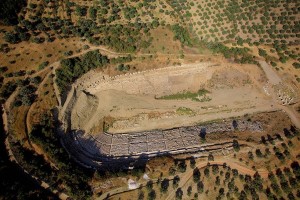Seats of honour for doping manufacturers

FAU researchers find inscriptions in ancient stadium
When athletes are suspected of doping, people try to deny all knowledge of it – the athletes themselves, the trainers and the manufacturers of prohibited drugs. In ancient times, things were completely different: contestants used various substances to enhance their performance – bull’s blood, alcohol, poppy or mushrooms. And unlike in modern days, the producers of these substances were probably held in high social esteem. This is the conclusion FAU researchers have drawn based on excavations of the ancient city Magnesia on the Maeander in what is now Turkey.
The mandrake root is frequently mentioned in connection with doping in ancient times. This poisonous plant with the Latin name Mandragora was considered magical in antiquity, with various powers being ascribed to it. Together with Turkish colleagues from the University of Ankara, FAU historians have found a very strong indicator that Mandragora was used to enhance athletic performance. During excavations in the formerly Greek stadium Magnesia in the south-west of Turkey, researchers found numerous inscriptions on podiums and seats. In an especially representative part of the stadium, namely its rotunda – and in seats of honour at that – the researchers have found an inscription for a group called the Mandragoreitoi. A village near Magnesia was called Mandragoreis, named after the plant that was cultivated there: Mandragora. Prof. Dr. Boris Dreyer, professor of Ancient History, is certain that they were given this privilege because they helped local athletes succeed with their merchandise: ‘The Greeks obviously had no problem with doping.’
Apart from the mandrake growers, priests and city officials filled the particularly attractive seats in the top rows; there were also seats of honour for representatives of other cities and provinces and special areas for garden tenders, bread bakers, bird vendors and political action committees. ‘These inscriptions, which are one of a kind and uniquely well-preserved, give us insight into the way cultural and sporting events were organised and which social rank members of the audience had,’ Dreyer explains.
The ancient stadium of Magnesia
Starting in the second century BC, the horseshoe-shaped stadium of Magnesia, which had a capacity of 30,000 visitors and was approximately 200 metres long, was used as a venue for running competitions, boxing matches, horse races and possibly gladiator games in honour of the city’s patron goddess Artemis and other deities. In 1984 the University of Ankara began excavating the edifice, which was buried under several metres of clay, under the leadership of Prof. Dr. Orhan Bingöl. Although the entire stadium has not been unearthed yet, the researchers have gained a clear concept of its layout: the structure was divided into 27 kerkides – what would be called blocks in a modern stadium – with 26 rows of seats each; the seats consisted of blocks of marble that were 39 centimetres high. Boris Dreyer has been involved in the analysis of inscriptions and symbols in the Magnesia stadium since 2011.
Further information:
Prof. Dr. Boris Dreyer
Phone: +49 (0)9131 85 25768
boris.dreyer@gesch.phil.uni-erlangen.de